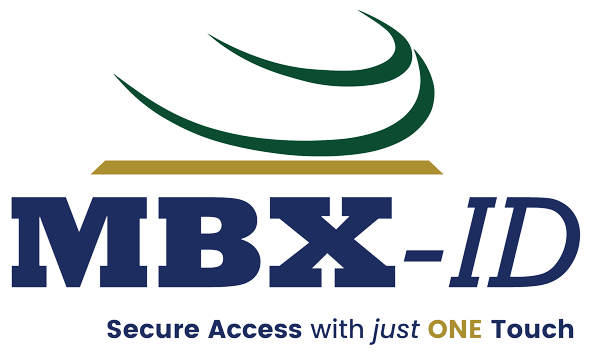FAQ
Unlike the typical RFID card, the RFID antennas of the MBX-ID are undiscoverable until an on-card biometric authentication takes place. Once the user biometrically authenticates himself or herself to the credential, the microprocessor within the MBX-ID validates the match and makes the antennas discoverable again during the transaction, whether opening a door or logging into a computer.
The user must download the MBX-ID enrollment app from the Google Pay Store. A username and password associated with the serial number of the MBX-ID must be registered in advance. The Enrollment app will prompt the user to scan each finger multiple times until there are enough scans to create a “templet” for that. The MBX-ID Enrollment app will soon be available on the Apple App Store and on the Windows store as well. A user’s fingerprints are enrolled directly onto the MBX-ID itself and never need to pass-thru or be stored on a database of server. This is critical in the on-going compliance requirements of GDPR (General Data Protection Rights), the CCPA (California Consumer Protection Act) and the growing number of BIPAs (Biometric Information Protection Acts).
The MBX-ID is designed with firmware allowing the enrollment of up to ten (10) fingers. The ten fingers do not need to be enrolled concurrently. During or after enrollment, each finger can be assigned to a particular wireless function, such as RFID MiFare, RFID, iClass, BLE physical access, BLE Windows Hello, BLE Real-Time Location, 5G duress and others.
Yes, the MBX-ID will store up to ten fingers from the same or multiple users. An example might be a police evidence locker that can only be accessed by five officers. In this example, a single MBX-ID could be used by any of the five officers to gain access to the locker. The default setting is that once the ten fingers have been enrolled, no other fingers (or persons) can be enrolled. However, an administrator has the ability to delete the enrolled fingers and reissue the MBX-ID to another individual.
The MBX-ID utilizes a capacitive fingerprint sensor produced by Fingerprint Cards AB, a Swedish manufacture that has deployed a billion+ sensors. The MBX-ID uses a large sensor array (160 X 160 pixels) with 508 DPI resolution, enabling the most robust matching capability in the market. In most cases, the capacitive technology within the MBX-ID will enroll just about any finger, with few exceptions.
The FAR is 1 in 50,000.
Yes. The MBX-ID will work with your existing infrastructure, without the need to change your readers. you can integrate the use of MBX-ID while phasing out your existing/older ID populations.
Yes. An organization may start by issuing the MBX-ID to those who need access to specific areas of the facilities, such as the server room, an R&D lab or the NICU or nursery area in a hospital.
1. Both the MBX-ID and a mobile device have plusses and minuses, depending on the use case and environment. Below are a few:The main advantage of the mobile device is that most employees own one and carry it with them all of the time.
2. In the vast-majority of cases, phones are owned by the user and not the enterprise. Most employee unions don’t allow employer apps on the employee’s personal device.
3. With a personal mobile device, the owner controls the loading of biometrics (typically just one finger) on the device. The owner, not the employer, controls who is biometrically enrolled.
4. Most phones still utilize a back-door PIN code for access that can be shared/stolen.
5. Typically phones are always connected (Wi-Fi or Cellular and Bluetooth) and thereby discoverable by bad actors.
6. Employee-owned phones have innumerable other applications within them, allowing malware and back-door access to the device.
7. Employee-owner phones aren’t allowed in most enterprises secure environments, call centers, hospital operating rooms and other critical areas.
8. Where is the best fit for the MBX-ID as opposed to a mobile device?
9. The best fit for the MBX-ID are environments where an employee typically wears a picture ID badge or where the multiple functions (physical access, logical access, RTLS, Time & Attendance and Personal Safety) of the MBX-ID can be fully utilized. Additionally, there are many facilities where personal mobile devices are prohibited.
The MBX-ID has an internal, rechargeable battery that can be recharged like a mobile phone.
Yes, but due to the thickness of the MBX-ID, only card printers that accept media of 40 mils should be considered.
No. Due to the amount and sophistication of the electronics within the MBX-ID, it is unable to be punched.
Any access control system that utilizes HID, , LEGIC, DESIFIRE/MIFARE or FIDO2 credentials. The MBX-ID is typically matched with the existing access control readers.
Yes. Contact your MBX-ID representative to discuss at sales@mbxbiometrics.com.
MBX-ID with MiFare DESfire
· MBX-ID with MiFare DESfire with 5G
· MBX-ID with MiFare DESfire with Legic and 5G
· MBX-ID with HID iPass and SEOS
· MBX-ID with HID iPass and SEOS with 5G
· MBX-ID with HID iPass and SEOS with Legic and 5G
Yes. The MBX-ID has been designed to support custom wireless technologies and protocols. Contact sales@mbxbiometrics.com for more information.

